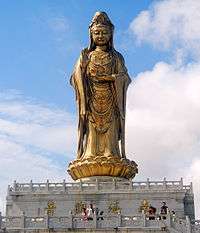觀音
Chinese
| observing | sound(s) cry(/ies) | ||
|---|---|---|---|
| trad. (觀音) | 觀 | 音 | |
| simp. (观音) | 观 | 音 | |

Etymology
“[One who] Observes Sounds”, in reference to the prayers and cries of sentient beings who need help, a calque of Sanskrit अवलोकितस्वर (avalokitasvara, literally “down-observe-sound”), the original form of अवलोकितेश्वर (avalokiteśvara, “Avalokiteśvara”), the bodhisattva who embodies the compassion of all Buddhas.
Synonymous with 觀世音/观世音 (Guānshìyīn, “One who Observes the Sounds of the World”), which interpreted the middle element of the Sanskrit compound as लोक (loka, “world”). The shorter form became more common during the Tang dynasty to avoid naming the taboo personal name of Emperor Taizong of Tang.
Compare Tibetan སྤྱན་རས་གཟིགས (spyan ras gzigs, literally “one who looks down with an unwavering eye”).
Pronunciation
Proper noun
觀音
Usage notes
Although Avalokiteśvara was reckoned a male figure and Guanyin was first depicted as a male in Chinese art, she is now almost always understood to be and referenced as a goddess or female boddhisattva.